As the seasons change
I stand on the border not
Knowing where to turn
The sweet scent of autumn leaves
The cold crisp taste of snowflakes
(A winter’s day in San Antonio)
As the seasons change
I stand on the border not
Knowing where to turn
The sweet scent of autumn leaves
The cold crisp taste of snowflakes
(A winter’s day in San Antonio)
Cool winter evening
The fire-flowers blossom
One by one, they bloom
In my heart, an ember burns
Hope, glowing, warming my soul
(Fireworks in the New Year)

#inktober

百花斉放 ひゃっかせいほう HYAKKA SEIHOU “A hundred flowers blooming” A blooming of the arts and sciences. I thought it was a fine sentiment to begin Inktober with.
I won’t be doing this every time, but I wanted to show a little of the background work that goes into this seemingly simple piece. Alas, I had no one around to take pictures as I actually brushed things out, but here’s an outline of the process.
百花斉放 is a yojijukugo, a four kanji character compound that acts as a proverb. There are thousands of these in the Japanese language, many of which came from Chinese works, which can make them a little challenging to translate. Jim Breen has a collection of them here, although I’m not sure what order he used. I found mine via this book here which was put together by my shodo teacher, Tony K. Skeen. In this book, the yojijukugo are in kana order (a,i,u,e,o/ ha, hi, fu, he, ho…etc) and therefore easier to find.
The first thing I do when I find a phrase I want to brush out is to cross-reference. In doing so, I double-check the translation, figure out the stroke order, and find examples of the style I want to brush out. This takes me across at least 3 or 4 dictionaries (or the internet if I can’t find what I need in the books).

I use the New Nelsons Japanese-English Character dictionary, Hadamitsky/Spahn’s A Guide to Writing Kanji and Kana for stroke order, and a 3-style Japanese Calligraphy Dictionary 現代書道三体字典 : コンパクト Gendai shodō santai jiten : Konpakuto (Modern shodo in three styles dictionary, compact version) by KISEKI Motohashi for the style examples.
Side note: if I am working on something for an SCA project, I will usually also try to find some style examples from extant historical documents. I know that there are some historical Japanese calligraphic dictionaries (I have seen a few), but with my middle-school Japanese, it’s hard for me to track them down easily.
So in the next four pictures, I cross reference each kanji from Hadamitsky/Spahn to the Gendai shodo santai jiten. I skipped taking pictures of looking up things in the Nelsons as it is a thick book and I couldn’t balance the camera!

Hyaku 百 meaning “100”
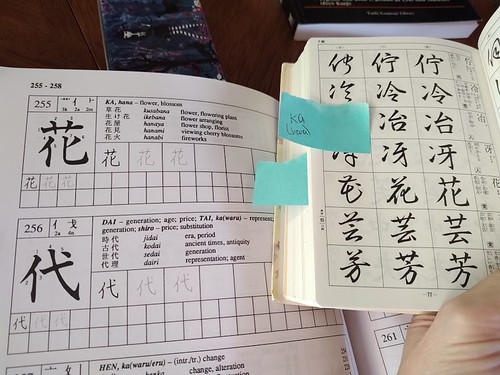
Ka 花, which is the ON (Sino-Japanese) pronunciation of hana, meaning “Flower”

Sei 斉 meaning “equal” or in the case “all at one time”

Hou 放 meaning “release” or “set free”
So literally, one hundred flowers released at the same time, or as we might say more poetically in English “one hundred flowers blooming” or “a hundred flowers blossoming”. Translation: it’s both an art and a science! In this instance, the phrase is referring to a blossoming of the arts and sciences, like what we might call a golden era or renaissance.
I’d like you to notice a few things in these pictures. Compare the computer kanji that is in this entry to the written kanji in the larger book, and then the three examples in the smaller book. THIS is the difference between just writing kanji and doing calligraphy. One of the things I see so often is people using computer kanji as their basis for kanji used in SCA scrolls. NO. PLEASE DON’T DO THIS. It’s like using the Times New Roman font as an exemplar for a 14th century scroll!!
If you notice, the smaller book shows three types of writing for each kanji. From right to left (and remember, the Japanese read right to left, not left to right), the styles are Kaisho (block script), gyousho (semi-cursive script), and sosho (cursive script).
While I chose to use sosho for my phrase today, I still practiced the kaisho. The reason for that is to get the stroke order correct and notice how some of the elements transmute when used in cursive. The gyousho is very helpful for seeing how the change happened, and while it was and is a widely used form, I don’t like it much.
So next, I had to consider the paper I was planning to use. A merchant had sent me some samples of this handmade washi paper and I thought it might be nice to try. However, I had to take into consideration that the size is smaller than the paper I usually use, as seen below:

I often use phone book or newspaper to practice kanji on when I am trying to get a sense of the shape. Here’s a comparison of my small phone book paper to the sheet I wanted to use. I would have to keep the size difference in mind as I practiced.

Again, I apologize for the lack of in-situ pictures. Here’s my normal set-up when doing brush calligraphy:
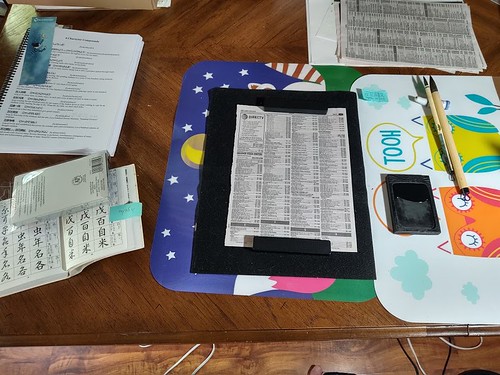
Examples to the left so I can see them, brushes and suzuri (ink stone) to the right, paper up top. Bunshin paperweights hold the paper in place and below the paper is a shitajiki, felt that absorbs ink since it tends to seep through the paper. The garish plastic placemats are extra protection since I’m doing this work on my dining table!
So here are some practice runs on the various kanji, in both kaisho and sosho forms:
HYAKU
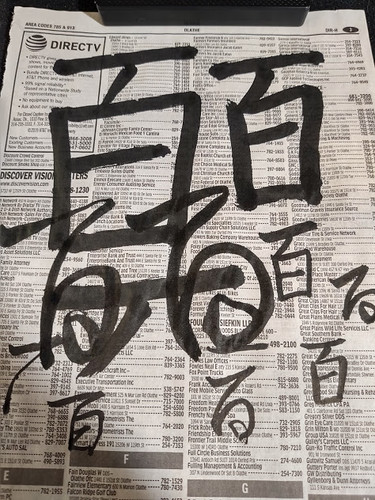

KA

SEI

HOU

And a few run-throughs of Hyakka Seihou. I’m messing a bit with the placement of the kanji in reference to each other. Sei especially wants to run larger than the others and is being a pain!
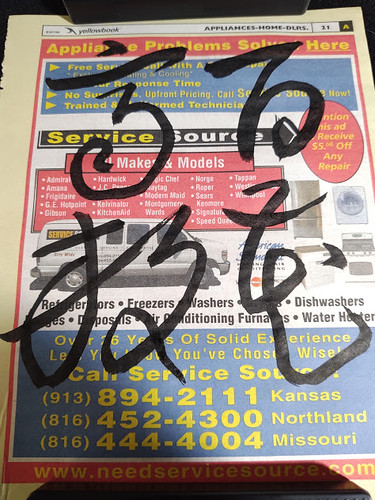


And finally, brushing the phrase on the special washi paper. I was actually going to do a couple of runs at this (because I wasn’t sure how the paper would take the ink), but the first one came out fairly well.
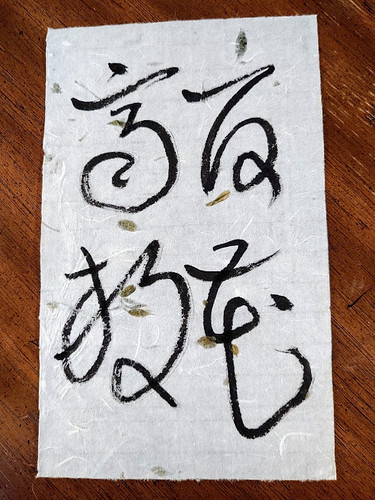
I actually wanted to do more practices, but honestly, there’s just a time when you have to do it and be done. It’s never going to be perfect to my eyes. The one thing I might have changed is leaving a bit more room at the left side for a seal signature. However, since I haven’t finished designing and carving my inkan (seal) yet, I felt the point was moot.
Hope this walk-through helps explain the process. The result is very simple and understated but there is a lot of work that goes on in the background!
Decided to try Inktober this year as a way to encourage me to get into a daily art habit. I’m sure there will be challenges, as this is always a difficult time of year for me, and moreso this year, but in art is solace.
I don’t intend to follow any prompts. My only goal is to do something inky. And some of it will be modern and not SCA-related, because I get a bit weary of how SCA takes over all my hobbytime. Anyway, I intend to try different media and different types of things. There will be shodo, sumi-e, regular ink drawings, maybe some knotwork? I just want to play with the medium. Most of my drawing experience has actually been with graphite and charcoal, so there is a learning curve.
Here are some sketches I did today (to ink during October):


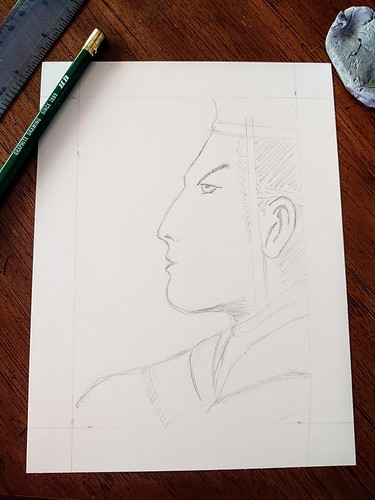

I also prepped by finding several yojijukugo (four kanji compound sayings, kinda like shorthand proverbs) that I want to brush out. Probably in sosho, but we’ll see how I feel on the day of. I’m using the book Yojijukugo: 4 Character Compound Reference Source for Japanese Brush Calligraphy by my shodo teacher, Tony Skeen. He’s been urging me to do this anyway, so Inktober is a perfect excuse.
With the calligraphy, there is a lot of prep that goes into each finished project. I get the kanji from the book, but then I need to look it up in Nelson’s Japanese/English dictionary, then cross-reference it to one of my exemplars (different sources based on the style). This is to get the stroke order and also get a sense of what the stylized kanji is supposed to look like. Next comes the practice, where I get comfortable brushing out the kanji and also working out size and spacing. I’ll brush the whole piece out a few times before doing a final one.
(Arrgh, that reminds me, I still need to finish designing my inkan stamp!)
With the sumi-e, I have some instruction books with some exercises to work through. While I would love to do some color work, I think I’ll stick with black and white for this month. Same thing with the knotwork. I’ve done some knotwork on scrolls in the past but never felt very comfortable with it, so I’d like to play around with it a bit. Maybe mess about with some vinework, too.
Really looking forward to this. It’ll be fun!
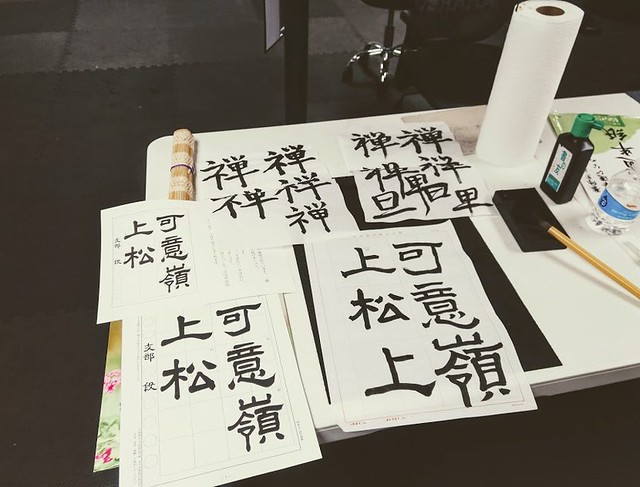
Life happened and I had to start my 100 Days of Arts and Sciences from scratch. I’m on Day 6. Here’s what I’ve been doing so far:
Day 1: practiced Reisho style in Japanese calligraphy, sewing on kosode sloper (working on a new pattern), research on tanka poetry.
Day 2: tanka poetry research, hand sewing, recorder practice
Day 3: hand sewing
Day 4: hand sewing, garb research
Day 5: hand-sewing, kanji radical practice
Day 6: Tanka poetry research, started on new hyakushu (100 poem sequence) project, practiced soprano recorder, hand-sewing on kosode sloper
Day 13: went to shodo lesson, took apart old meisen-silk haori. Not one of the better piece I have, although a nice black/grey pattern. It’s heavily patched, and I might keep those pieces as real-life examples of how patching works, since I seem to have fallen into a research hole regarding that subject.
Day 14: Worked on RUSH class outlines, exploring reisho files that my shodo teacher gave me to work with, went through a couple of fabric bins of old kimono I haven’t taken apart yet. Was shocked to find that some of them might fit me now that I’ve lost so much weight! However, doing proper kitsuke would be a challenge, as even thin I am tall, with broad shoulders and hips. Still, wondering how I might be able to adapt a few of the plainer (ie less obviously modern) kimono into kosode without having to take them completely apart? Obviously change the sleeves. Length isn’t a problem because of my height, but not sure about how the width would play out. May try one and see what happens. I never expected to be thin enough to have these come close to fitting.
Met with friend regarding her project, shared research, need to make some scans and copies for her, and also dig up some literary references. Sorry about vagueness, not technically my project.
Made progress in my quest to make a byobu screen–talked with someone who might be willing to do the woodworking side of the project, or maybe at least show me how to do it? Anyway, that’s more than a year off, as I need to focus on making garb.
Sorted through some fabric, identifying some future projects utilizing fabric I have previously used in old outfits that I took apart. I really like the idea of reutilizing fabric when possible. Have a bit of a conundrum, though. I have some very nice Chinese brocade that I picked up on clearance years ago. It does have the right look for 16th century uchikake, but it is polyester and there is no getting around that. But the fabric was bought and paid for nearly 20 years ago, so I might as well use it? If nothing else, to learn the ins and outs of sewing uchikake inexpensively? Although poly doesn’t really act much like real brocade, but OTOH, real brocade is frightningly expensive…
Will post more on this, with pictures to illustrate what I’m talking about. I’m all about learning on the cheap stuff, but OTOH, it would be nice to look like I walked out of a picture, which is kinda hard to do with the cheap fabric sometimes.
Requested Inter-Library Loan on three books, no telling what luck I’ll have on them, but our library is usually pretty good about obtaining things. 2 books regarding boro (technically post-period, although there WAS patching in period per literature. The question would be to prove how it was done.) And trying again to get my hands on Kurihara Hiro and Kawamura Machiko. Jidai Ishō no Nuikata. Genryu-sha Joint Stock Co. Tokyo: 1984. I know people who have gotten it through ILL, but most of them were associated with universities. Not sure if it’ll fly from a civic public library.
Music practice cancelled, one of our trio was sick. Looked over the indices of a book on tenshou examples that my shodo teacher wrote. He’s added to the book since I bought it, but I need to identify which pages I need so I don’t have to buy a whole other book.
Research time, looking up examples for a friend’s project, which I can’t discuss further since she wants to surprise people. Also found out one of my favorite online sources, the Multilingual Pictopedia of Everyday Life in Medieval Japan is not where the old links used to be. Fortunately, I did download them and kept extra copies on another harddrive, but I hate that the PDFs aren’t available anymore. Several libraries in the US do have copies of the 3-volume work, although when I did Inter-Library Loan for them a couple of years ago, Stanford University charged me $20! (Most of the time ILL is free or maybe a couple of dollars at most!)
Got in some of the materials for my upcoming RUSH Japanese calligraphy classes. The ink is fine, but I’ll need to prep the brushes. That will probably take a few hours.

The canvas-weight shibori patterned material that I am taking apart to repurpose. Tried to make a kosode from it, but it is too thick and scratchy, and lining it would make it too warm. So it will be made into something else, probably some kind of carrying bags. I got the material cheap when Hancock’s went out of business, $11 for 9 yards.
Day 4 of 100 Days of Arts and Sciences. Soprano recorder practice, more on the kanji radicals workbook, shodo practice, pulled together some of my Japanese doll research to answer a question on SCA Japanese FB page.
Day 5 of 100 Days of Arts and Sciences. Practiced tenor recorder, wrote a couple of tanka, did some Japanese clothing research.
Day 6 of 100 Days of Arts and Sciences. Practiced soprano recorder, went to Shodo lesson, made progress on Class prep for RUSH, fell down research hole about how lower-class Japanese patched/repaired clothing. Mostly 19th and early 20th century information, but can certainly tie literary references to the practice (regrettably vague), but some Shōsō-in garments show this kind of patching or similar. Worth digging more into. Next few days will be slow, have some Real Life constraints on my time, but should be able to do something, even small!
Day 7 of 100 Days of Arts and Sciences. Nursing a migraine today, so just did some hand-sewing repair on a cloak and some zukin where threads had come loose. Took apart a trial kosode I made from some shibori-designed fabric I picked up on clearance when Hancock’s closed. Thought it might work for garb. It looks right but it is almost canvas weight and would be too hot and scratchy. Will probably repurpose the material to make bags or something like that instead. Waste not, want not.
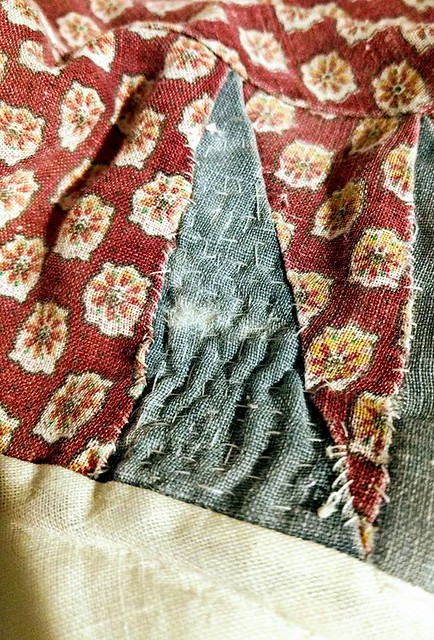
First attempt at using Japanese boro stitching technique to fix a frayed area on a quilt. Simple running stitch used in period. Not complete success. Need more even stitches, probably slap a patch over the area and then try running stitch and see how that goes. Just experimenting on an idea.
Day 8 of 100 Days of Arts and Sciences. Wrote two tanka and a haiku, more reading on Japanese work clothes, soprano recorder practice, sourcing materials for my RUSH classes (and trying to remember where I stashed those student brushes–I’ve given some away but I know I have more.) I need to fit in some time tomorrow to get that kosode sloper put together so I can see if my updated pattern works. #somedayiwillbeorganized #todayisnotthatday
Day 9 of 100 Days of Arts and Sciences. Still gathering materials for RUSH classes, continued reading book on Japanese work clothes, and taking apart failed canvas shibori kosode to reuse material.
Day 10 of 100 Days of Arts and Sciences. Updated SCA blog, finished reading book on Japanese work clothes, finished taking apart shibori kosode (fabric will be stored an be reworked into carrying bags later, after I get more clothing sewn!).
The book I’ve been reading about Japanese work clothes is Stories Clothes Tell: Voices of Working Class Japan by Horikiri Tatsuichi, translated by Reiko Wagoner. ISBN 1442265108 (ISBN13: 9781442265103). The author spent decades traveling around Japan and collecting examples of working-class clothing, mostly from the Meiji, Taisho, and early Showa era. (So he focused roughly 1868 to the early 1960’s in time period.) This book is a translation of several essays that Horikiri wrote concerning items from this collection. While he tends to go a little far in conjecture about items, the small details about these work clothes and how they were used is a fascinating read, if a bit melancholy since some of these stories really bring into focus how desperately poor these people were.
There are more “social histories” now than there used to be, that focus on the lives of the common people. Since the time period this book focused on was post-1600, many items he discussed were not exactly applicable to SCA, but his approach is certainly one we can apply. It was remarkable to see how slowly the clothing evolved in usage–Horikiri discusses the evolution of some of the items from Edo-period clothing. With a little work, some items might be placed before that. It would take looking at visual sources and perhaps literature, since no extant pieces would exist.
The book was also useful in isolating some Japanese terms regarding fabric and clothing and includes a glossary, although most of the items mentioned are Edo-period or later. Still, there is some hidden treasure here. In one essay, he speaks of the difference between the rough-woven asa 大麻(hemp) cloth used by the lower classes, and the finer-woven joufu 上布, which seemed to be linen or perhaps a mix of hemp and linen? Definitely of a much tighter weave, and according to this Japanese wikipedia article on 上布, there are some extant pre-1600 examples of joufu?
Anyway, it looks like it would be worthwhile to track down more of these specific terms, not often referenced in English language sources!